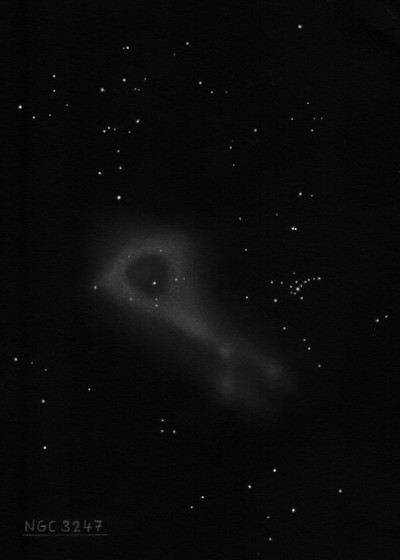
At 145x, fairly faint emission haze was easily visible in an irregular 2.5' region just to the east of Westerlund 2. A mag 12 star is embedded near the center of the nebula, a mag 11.5 star is just off the north edge and a few additional stars are involved. Adding a NPB filter, RCW 49 is a fairly bright, irregular nebula! The brightest part (centered on the star) was roughly circular with a well-defined northern boundary, but it spread further south and southwest to a ~4'x3' region.
Cr 220 (often misidentified as NGC 3247) is located ~15' SE of the NGC 3247 complex in the same low power field. Roughly three dozen stars were resolved at 145x in a 6' circle, with the central part slightly condensed. The brightest mag 9.8 star is at the north end with a mag 12 companion [13" separation]. A small quadrilateral of mag 13-13.5 stars [sides 14", 14", 18", 17"] is on the southwest side. No involved nebulosity was seen.
John Herschel discovered NGC 3247 = h3250 on 1 Apr 1834 and described "a curious object. Stars involved in evident nebula." The next sweep he logged, "there is a nebulous appearance, which merits re-examination. Observed much past meridian, and no reliance on the PD [polar distance]." A third observation only has a very approximate polar distance. His rough (mean) position is 10 24.8 -57 51 (2000). Joseph Turner unsuccessfully searched for this object using the 48" Melbourne Telescope on 12 Feb 1879, as well as Pietro Baracchi on three different occasions, perhaps due to Herschel's poor position.
Using a Harvard plate, DeLisle Stewart identified NGC 3247 at 10 23 58 -57 48.5 (2000), and Dreyer repeated this position in the IC 2 notes. Brian Skiff places NGC 3247 more accurately at 10 24 01 -57 45.6, corresponding with ESO 127-SC18 = Westerlund 2. This compact cluster (~1.5' dia) is embedded in the HII region RCW 49 = Gum 29, which spreads out ~10' in size. ESO and Lynga misidentify Cr 220 as NGC 3247. This group of stars is 1.0 tmin following and 5' south of JH's position.
300/350mm - 14" (4/4/16 - Coonabarabran, 145x and 230x): NGC 3247 consists of a compact cluster (often referred to as Westerlund 2), one of the most massive young star clusters known in the Milky Way, and a large, irregular H II region (RCW 49) with star-forming pillars similar to the Eagle Nebula. At 230x, the cluster extended ~1.5', but the richest part was a dense, elongated clump only 45" long with a half-dozen tightly packed mag 13.5-14 stars resolved in an WNW-ESE string. Off the SW side is mag 13.5 WR 20a, one of the most massive binary systems (both superluminous O3-type stars). The cluster is situated 12' N of mag 5.8 HD 90289.
Notes by Steve Gottlieb